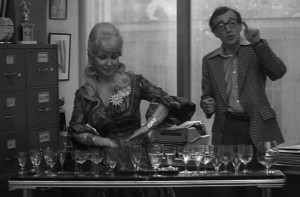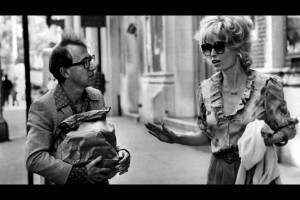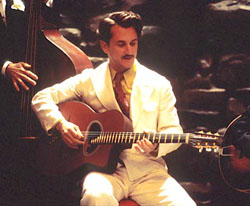From the Chicago Reader (August 31, 2001). Today (September 2, 2014), having recently reseen this movie, I’d probably give it a higher rating. — J.R.
The Curse of the Jade Scorpion
Rating ** Worth seeing
Directed and written by Woody Allen
With Allen, Helen Hunt, Dan Aykroyd, Brian Markinson, Elizabeth Berkley, Charlize Theron, Wallace Shawn, and David Ogden Stiers.
I don’t want to oversell Woody Allen’s 31st feature, which I happen to like. The script is full of holes, most of the one-liners are weak and mechanical, and the plot — a nightclub magician gets two of his hypnotized subjects to steal jewels for him — is so deliberately stupid and contrived that one can probably enjoy it only by pretending it’s a routine, low-budget second feature on an old-fashioned double bill, which is obviously what Allen intended. Yet it’s possible for a picture to be not very good and still be likable — something that doesn’t happen very often for me with Allen’s pictures. (It happened, momentarily, in Everyone Says I Love You — when Allen exposed his vulnerability by singing the first 16 bars of “I’m Thru With Love.”)
The problem with most escapism nowadays is that even if it makes you forget who and where you are, it doesn’t really detach you from norms of the world you’re living in. By contrast, part of the charm of The Curse of the Jade Scorpion, a color movie set in 1940, is that even though its two lead characters are mainly rude and hostile toward each other when they aren’t hypnotized, we don’t see any of today’s kind of self-absorbed rudeness, as when people talk on mobile phones while they walk or drive down the street, oblivious to everyone else. Indeed, for a little less than two hours, this picture helps us forget that such people exist.
C.W. Briggs (Allen) has been working as an adjuster/investigator at a New York insurance firm for 20 years, and Betty Ann Fitzgerald (Helen Hunt) has been an efficiency expert at the same company for six months. They may snap at each other a lot, but the movie overall is conceived as a duet between them. A duet is even what we hear behind the opening and closing credits — a lovely double improvisation by baritone saxophonist Harry Carney and alto saxophonist Johnny Hodges in Duke Ellington’s “Sophisticated Lady” — though working out which character corresponds to which saxophone isn’t as simple as it sounds, because both are gruff and aggressive and neither has the lyricism of Carney or Hodges. (Later, when the two characters develop romantic feelings for each other — mainly, it appears, thanks to posthypnotic suggestions — their love theme becomes a swing version of “How High the Moon.”)
A class difference can be detected in their apartments: his is seedy, shabby, and apparently windowless; hers is much fancier, roomier, and airier — though both feature florid wallpaper and chintzy upholstery that reek of 1940 (courtesy of production designer Santo Loquasto). One reason for the discrepancy may be the secret adulterous affair she’s carrying on with her boss, Chris Magruder (Dan Aykroyd). But the clearest class difference may be that she’s upwardly mobile, while C.W. is quite content to remain where he is — which is almost anomalous for a Woody Allen hero, and partly accounts for why I like him more than usual here. Judging from the nouveau riche anxieties that typically permeate his other pictures, it might be Betty Ann — or “Fitz,” as she’s usually called — with whom Allen identifies the most. More precisely, part of the tension between this dueling couple might stem from the fact that they represent the two sides of his personality.
I recently took another look at my favorite Allen picture, his sweet and underrated valentine to showbiz losers, Broadway Danny Rose (1984). This time I think I understood a little better why its title character, played by Allen — a small-time agent for hopeless entertainment acts who gives his all to his clients and never gets ahead — registers with such power and poignancy. Like John Updike’s most memorable character, Rabbit Angstrom, Danny Rose is a significant part of his creator but also his ostensible opposite, the phantom that haunts his sleep — a creation based on what he left behind when he moved away from the boondocks and became a professional success, which gives this character a moral force and authenticity that’s missing from Allen’s other heroes. C.W. is coarser and simpler than Danny Rose and considerably less generous — a street-smart yet embittered gumshoe who’s basically given up on romance and is content to flirt idly with an office secretary (Elizabeth Berkley, the star of Showgirls, virtually unrecognizable here) and have occasional one-night stands. He may be closer to a genre type than a character Allen understands personally, yet it’s interesting that Allen gives a real performance in the process of putting him together, rather than falling back on his usual persona. Apart from clearly being in his 60s, C.W. isn’t completely different from the usual Allen hero — neither is Danny Rose, for that matter — but in both cases affection for Allen’s working-class origins is allowed to creep into the performance, replacing the usual fear and disgust.
Allen’s other movies tend to be dominated by European art-movie influences, most often Bergman and Fellini, and it seems sadly typical of Allen’s class attitudes that these influences, Bergman in particular, seem to signify wealth for him, the kind of culture he appears to think money can buy. When he deals with the absence of wealth, typically with a certain amount of sneering and disdain, Fellini sometimes replaces Bergman — so it seems fitting that the favorite idle pastime of the jazz musician hero (Sean Penn) of Sweet and Lowdown, a character partly based on Anthony Quinn in Fellini’s La strada, is shooting rats in city dumps. (Radio Days, Allen’s spin on Fellini’s Amarcord, is more divided: the glamorous radio stars are mocked on occasion by the working-class characters, but those characters are also ridiculed by the celebrities.)
When his influences are predominantly American — Charlie Chaplin’s City Lights in Manhattan, Bob Hope in Annie Hall, Warren Beatty’s Reds in Zelig, Alfred Hitchcock’s Rear Window and Orson Welles’s The Lady From Shanghai in Manhattan Murder Mystery — a warmer and less wormy Allen persona emerges. (The presence of Diane Keaton or Mia Farrow in these pictures and in Broadway Danny Rose undoubtedly contributes to this effect.) This is also the case in The Curse of the Jade Scorpion, where, as in Annie Hall and Broadway Danny Rose, art cinema is no longer a model.
There are phrases in the dialogue that don’t belong to the 40s (Berkley’s character, for instance, is said to have “a body that won’t quit”), and though Allen takes the trouble to model Charlize Theron’s Laura Kensington after the 20-year-old spoiled, vampish Carmen Sternwood, who cruises Philip Marlowe at the beginning of The Big Sleep, he’s less careful with other plot details. In a spirit of avowed sexual experimentation, Laura turns up in C.W.’s flat with a bottle of 120-proof Russian vodka and quickly climbs into his bed. The phone rings before he can join her — it’s the hypnotist, ordering him off on a safecracking mission — and C.W., in a trance, promptly sends her home. The next day detectives hired by Magruder find an empty vodka bottle in C.W.’s flat, but how anyone ever had time to empty it is never explained. Similarly, Fitz’s affair with Magruder is supposed to be a secret from everyone except C.W., who learns about it by accident; yet when the detectives need to reach Magruder, they phone him at Fitz’s apartment, and Fitz doesn’t hesitate to hand him the receiver.
I interpret these gaffes as accidental rather than as efforts to ape the clumsiness of silly second features, but they still work to Allen’s advantage. He’s let his guard down and has allowed himself and his audience to relax — something that doesn’t often happen when the specters of class and European art hover over his pictures.








